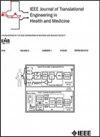A Clinical Tuning Framework for Continuous Kinematic and Impedance Control of a Powered Knee-Ankle Prosthesis
IF 4.4
3区 医学
Q2 ENGINEERING, BIOMEDICAL
IEEE Journal of Translational Engineering in Health and Medicine-Jtehm
Pub Date : 2025-03-07
DOI:10.1109/JTEHM.2025.3567578
引用次数: 0
Abstract
动力膝踝假体连续运动和阻抗控制的临床调谐框架
目的:假肢的配置是装配过程中不可或缺的一部分,但多模态动力膝关节-踝关节假体的个性化往往过于复杂,难以在临床环境中实现。本文开发了一种个性化的混合运动阻抗控制器的技术手段,用于可变倾斜度的行走和坐立转换,以及一个直观的临床调整界面(CTI),允许义肢医生直接修改控制器的行为。方法和步骤:利用一种已建立的预测运动学步态个性的方法以及一种新的运动个性的并行方法,我们对关节阻抗(在站立期间)和运动学(在摆动期间)的连续相位/任务模型进行了个性化,该模型仅使用平地行走的调谐特性。为了利用这种方法,我们开发了一个CTI,将常见的临床调整参数转换为步行和坐立控制器的模型调整。然后,我们进行了一个案例研究,在一个模拟的临床过程中,一名义肢专家反复调整动力义肢,让一名膝盖以上的截肢者参与其中,包括坐立转换和水平行走,从中自动校准倾斜/下降行走特征。结果:多活动义肢控制器在20分钟内完成全调优。每次调优(即观察、参数调整、模型再处理)平均耗时2分钟,坐下站立平均耗时1分钟。在手动调整任务和自动调整任务(倾斜)中,调整后的行为变化适当地体现在命令的假肢扭矩中。结论:CTI利用健全身体的趋势,有效地个性化了广泛的步行任务和坐立转换,证明了动力膝踝假体在临床上可行的必要效率。临床影响:本文介绍了一种临床调优界面,简化了多模态机器人假肢腿的调优过程,将所需时间从几个小时减少到20分钟,从而提高了临床可行性。
本文章由计算机程序翻译,如有差异,请以英文原文为准。
求助全文
约1分钟内获得全文
求助全文
来源期刊

IEEE Journal of Translational Engineering in Health and Medicine-Jtehm
Engineering-Biomedical Engineering
CiteScore
7.40
自引率
2.90%
发文量
65
审稿时长
27 weeks
期刊介绍:
The IEEE Journal of Translational Engineering in Health and Medicine is an open access product that bridges the engineering and clinical worlds, focusing on detailed descriptions of advanced technical solutions to a clinical need along with clinical results and healthcare relevance. The journal provides a platform for state-of-the-art technology directions in the interdisciplinary field of biomedical engineering, embracing engineering, life sciences and medicine. A unique aspect of the journal is its ability to foster a collaboration between physicians and engineers for presenting broad and compelling real world technological and engineering solutions that can be implemented in the interest of improving quality of patient care and treatment outcomes, thereby reducing costs and improving efficiency. The journal provides an active forum for clinical research and relevant state-of the-art technology for members of all the IEEE societies that have an interest in biomedical engineering as well as reaching out directly to physicians and the medical community through the American Medical Association (AMA) and other clinical societies. The scope of the journal includes, but is not limited, to topics on: Medical devices, healthcare delivery systems, global healthcare initiatives, and ICT based services; Technological relevance to healthcare cost reduction; Technology affecting healthcare management, decision-making, and policy; Advanced technical work that is applied to solving specific clinical needs.
 求助内容:
求助内容: 应助结果提醒方式:
应助结果提醒方式:


